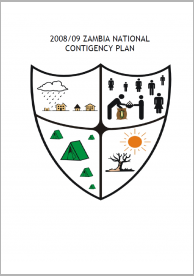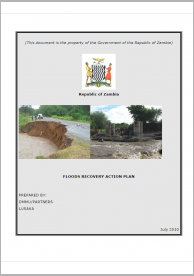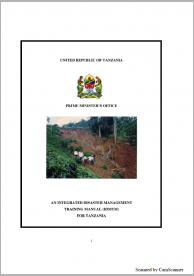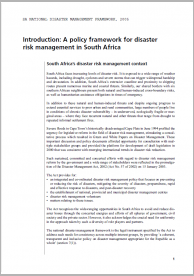
This contingency plan covers the planned activities to be undertaken in 2008/09 rainy season with scenarios for the likely occurrence of floods based on the Zambia Meteorological Department (ZMD) rainfall forecasts.
The following is a list of all conten labeled as "Education & School Safety"

This contingency plan covers the planned activities to be undertaken in 2008/09 rainy season with scenarios for the likely occurrence of floods based on the Zambia Meteorological Department (ZMD) rainfall forecasts.

Recovery Action Plan with specific activities and costing that result from the proposed recommendations in the 2009/2010 In-Depth Vulnerability and Needs Assessment Report that was undertaken in 17 districts.

The Seventh National Development Plan (also known as 7NDP) was born out of Zambia's aspiration to be a prosperous middle-income country by 2030. To achieve this aspiration, it is imperative that the country articulates the processes, interventions and actions that will propel development towards this desired state.

This contingency plan covers the 2009-2010 rainy season with the likely scenario of having floods as a hazard. This scenario is based on the 2009-2010 rainfall forecast for the country obtained from the Zambia Meteorological Department (ZMD). It anticipates that a total population of 713,193 people (118,866 households) residing in 43 districts are likely be affected by floods.

The IDTMTM was developed to promote efforts addressing disaster issues in Tanzania, informing the public about the major disasters that affect the community.

The Malawi Post Disaster Needs Assessment for the 2019 Floods was commissioned by the Government of Malawi with support from The World Bank, United Nations Development Programme (UNDP), European Union (EU) and African Development Bank (AfDB).

The national disaster management framework is the legal instrument specified by the Disaster Management Act to address the need for consistency across multiple interest groups, by providing a coherent, transparent and inclusive policy on disaster management appropriate for the Republic as a whole.

The Seychelles Sustainable Development Strategy (SSDS) 2012-2020 is an approved national instrument which incorporates national priorities for sustainable development and lays out a roadmap for the implementation of those priorities.

The National Disaster Management Agency (NDMA) commissioned a Mid-Term Review (MTR) in November 2016 supported by the Swaziland UN Country Office focusing primarily on the period beginning from the National Emergency Response Mitigation and Adaptation Plan (NERMAP) launch (February 2016) to December 2016.

The 2015/2016 El Niño induced drought was the worst the country has experienced in over thirty-five years. In 2016, the National Emergency Response Mitigation and Adaptation Plan (NERMAP) 2016-2022 was developed and implemented with success during the response phase of the first year.